Top Rankings
River Delta Joint Unified School District ranks among the top 20% of public school district in California for:
Category
Attribute
Graduation Rate
Highest graduation rate (Top 10%)
For the 2025 school year, there are 6 public high schools serving 756 students in River Delta Joint Unified School District. This district's average high testing ranking is 3/10, which is in the bottom 50% of public high schools in California.
Public High Schools in River Delta Joint Unified School District have an average math proficiency score of 12% (versus the California public high school average of 28%), and reading proficiency score of 37% (versus the 51% statewide average).
Public High School in River Delta Joint Unified School District have a Graduation Rate of 95%, which is more than the California average of 87%.
The school with highest graduation rate is Delta High School, with ≥95% graduation rate. Read more about public school graduation rate statistics in California or national school graduation rate statistics.
Minority enrollment is 72% of the student body (majority Hispanic), which is less than the California public high school average of 79% (majority Hispanic).
Overview
This School District
This State (CA)
# Schools
11 Schools
2,817 Schools
# Students
1,747 Students
2,139,525 Students
# Teachers
93 Teachers
100,737 Teachers
Student : Teacher Ratio
19:1
19:1
District Rank
River Delta Joint Unified School District, which is ranked #1132 of all 1,925 school districts in California (based off of combined math and reading proficiency testing data) for the 2021-2022 school year.
The school district's graduation rate of 95% has increased from 90-94% over five school years.
Overall District Rank
#1205 out of 1941 school districts
(Bottom 50%)
(Bottom 50%)
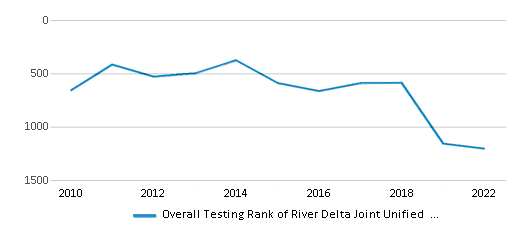
Math Test Scores (% Proficient)
21%
33%
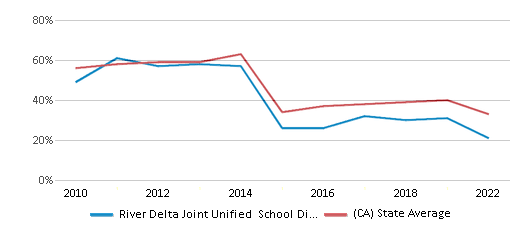
Reading/Language Arts Test Scores (% Proficient)
40%
47%
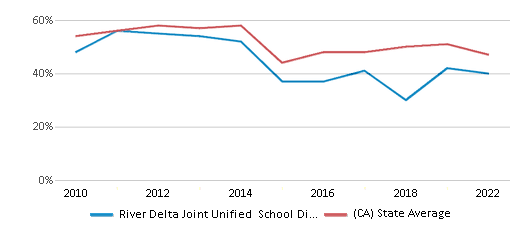
Science Test Scores (% Proficient)
25%
29%
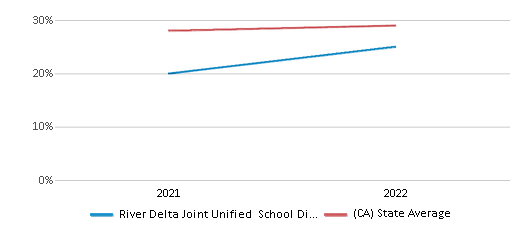
Graduation Rate
≥95%
87%
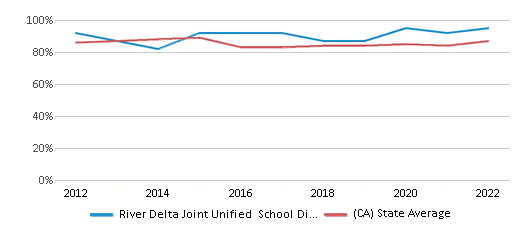
Students by Ethnicity:
Diversity Score
0.57
0.63
# American Indian Students
11 Students
10,468 Students
% American Indian Students
1%
1%
# Asian Students
30 Students
244,247 Students
% Asian Students
2%
11%
# Hispanic Students
1,037 Students
1,190,384 Students
% Hispanic Students
59%
56%
# Black Students
44 Students
110,575 Students
% Black Students
2%
5%
# White Students
501 Students
458,887 Students
% White Students
29%
22%
# Hawaiian Students
12 Students
9,060 Students
% Hawaiian Students
1%
n/a
# Two or more races Students
112 Students
108,483 Students
% of Two or more races Students
6%
5%
Students by Grade:
# Students in PK Grade:
-
18
# Students in K Grade:
182
25,126
# Students in 1st Grade:
95
19,346
# Students in 2nd Grade:
125
19,826
# Students in 3rd Grade:
109
19,554
# Students in 4th Grade:
105
19,798
# Students in 5th Grade:
108
20,237
# Students in 6th Grade:
105
29,089
# Students in 7th Grade:
154
39,371
# Students in 8th Grade:
132
41,955
# Students in 9th Grade:
161
466,491
# Students in 10th Grade:
148
476,582
# Students in 11th Grade:
169
469,509
# Students in 12th Grade:
154
492,623
# Ungraded Students:
-
-
District Revenue and Spending
The revenue/student of $17,155 in this school district is less than the state median of $19,974. The school district revenue/student has grown by 7% over four school years.
The school district's spending/student of $14,912 is less than the state median of $18,396. The school district spending/student has grown by 7% over four school years.
Total Revenue
$30 MM
$116,387 MM
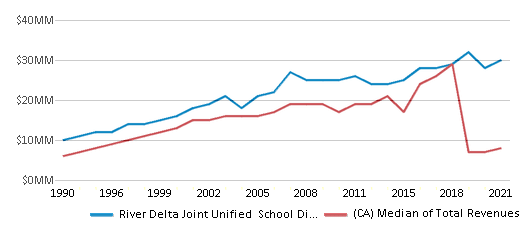
Spending
$26 MM
$107,188 MM
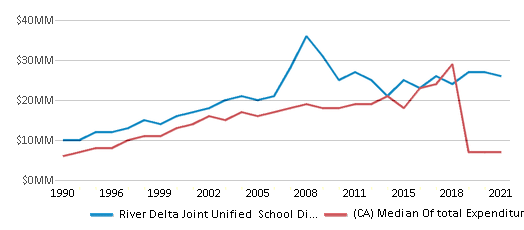
Revenue / Student
$17,155
$19,974
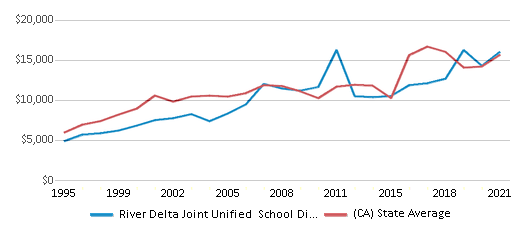
Spending / Student
$14,912
$18,396

Best River Delta Joint Unified School District Public High Schools (2025)
School
(Math and Reading Proficiency)
(Math and Reading Proficiency)
Location
Grades
Students
Rank: #11.
River Delta High/elementary (Alternative)
Alternative School
(Math: <50% | Reading: <50%)
Rank:
Rank:
8/
Top 30%10
525 So. Second St.
Courtland, CA 95615
(707) 374-1324
Courtland, CA 95615
(707) 374-1324
Grades: K-12
| 26 students
Rank: #22.
Mokelumne High (Continuation School)
Alternative School
(Math: <50% | Reading: <50% )
Rank:
Rank:
7/
Top 50%10
160 Courtland High School Ln.
Courtland, CA 95615
(916) 775-1771
Courtland, CA 95615
(916) 775-1771
Grades: 9-12
| 8 students
Rank: #33.
Delta High School
(Math: 10-14% | Reading: 40-44%)
Rank:
Rank:
4/
Bottom 50%10
52810 Netherlands Ave.
Clarksburg, CA 95612
(916) 744-1714
Clarksburg, CA 95612
(916) 744-1714
Grades: 10-12
| 183 students
Rank: #44.
Rio Vista High School
(Math: 6-9% | Reading: 45-49%)
Rank:
Rank:
4/
Bottom 50%10
410 South Fourth St.
Rio Vista, CA 94571
(707) 374-6336
Rio Vista, CA 94571
(707) 374-6336
Grades: 9-12
| 350 students
Rank: #55.
Clarksburg Middle School
(Math: 10-14% | Reading: 25-29%)
Rank:
Rank:
2/
Bottom 50%10
52870 Netherlands Rd.
Clarksburg, CA 95612
(916) 744-1717
Clarksburg, CA 95612
(916) 744-1717
Grades: 7-9
| 187 students
Rank: n/an/a
River Delta Community Day
Alternative School
160 Courtland High School Ln.
Courtland, CA 95615
(916) 775-1771
Courtland, CA 95615
(916) 775-1771
Grades: 7-12
| 2 students
Recent Articles

What Is A Charter School?
Explore the world of charter schools in this comprehensive guide. Learn about their history, how they operate, and the pros and cons of this educational innovation. Discover key facts about charter schools, including admission policies, demographics, and funding, as well as what to look for when considering a charter school for your child.

10 Reasons Why High School Sports Benefit Students
Discover the 10 compelling reasons why high school sports are beneficial for students. This comprehensive article explores how athletics enhance academic performance, foster personal growth, and develop crucial life skills. From improved fitness and time management to leadership development and community representation, learn why participating in high school sports can be a game-changer for students' overall success and well-being.

February 05, 2025
Understanding the U.S. Department of Education: Structure, Impact, and EvolutionWe explore how the Department of Education shapes American education, from its cabinet-level leadership to its impact on millions of students, written for general audiences seeking clarity on this vital institution.





